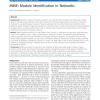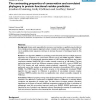45 search results - page 6 / 9 » Inferring modules of functionally interacting proteins using... |
BMCBI
2011
12 years 9 months ago
2011
Background: Graphical models of network associations are useful for both visualizing and integrating multiple types of association data. Identifying modules, or groups of function...
BMCBI
2007
13 years 6 months ago
2007
Background: Staphylococcus aureus is a human pathogen that causes a wide variety of lifethreatening infections using a large number of virulence factors. One of the major global r...
RECOMB
2006
Springer
14 years 6 months ago
2006
Springer
Computational and comparative analysis of protein-protein interaction (PPI) networks enable understanding of the modular organization of the cell through identification of functio...
BMCBI
2008
13 years 6 months ago
2008
Background: Amino acids responsible for structure, core function or specificity may be inferred from multiple protein sequence alignments where a limited set of residue types are ...
BMCBI
2011
13 years 29 days ago
2011
Background: Atomic Solvation Parameters (ASP) model has been proven to be a very successful method of calculating the binding free energy of protein complexes. This suggests that ...


